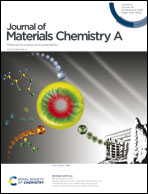2D hydrogenated boride as a reductant and stabilizer for in situ synthesis of ultrafine and surfactant-free carbon supported noble metal electrocatalysts with enhanced activity and stability†
Abstract
The common problems with carbon-supported noble metal catalysts, which are the most widely used catalysts in scientific and commercial cases, are their poor dispersion and stability, and the large particle size of the noble metal. Herein, we uncover the reducibility of 2D hydrogenated boride (HB) towards noble metal ions, such as Pt,Cl42−, PdCl42− and AuCl4−, for synthesizing ultrafine and surfactant-free noble metal nanoparticles. Furthermore, inspired by these results, carbon supported noble metal nanoparticle electrocatalysts (M/B–C, M = Pt, Pd and Au) with an ultrafine size (2–3 nm) and a high dispersion were prepared using a simple mixing-stirring-filtering (MSF) method at room temperature, and the amount of noble metal loading reached as high as 52.9 wt%. There are no organic surfactants or other reductants involved in the entire preparation process. In light of the ultrafine size and clean surface, the M/B–C catalysts exhibit an activity that surpasses that of their commercial counterparts. The theoretical calculations indicate that the as-formed noble metal nanoparticles (NPs) present a much stronger interaction with the HB hydrolysate, that is, a 2D boron sheet, than that with carbon black, contributing to the excellent catalytic durability of M/B–C. This work provides a novel strategy for synthesizing carbon-supported noble metal electrocatalysts with an enhanced activity and durability.



 Please wait while we load your content...
Please wait while we load your content...